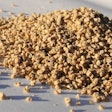
The cost of both energy and protein in poultry diets have flirted with record high levels over the past year. These high costs put a premium on squeezing every bit of nutrition out of feedstuffs to keep costs down and improve bottom line results. Dr. Roselina Angel, professor, University of Maryland, speaking at the 2012 Midwest Poultry Federation Convention Pre-Show Nutrition Symposium, said that nutrient digestion and absorption from poultry diets can be influenced by a number of factors, including the addition of enzymes to the diet.
Improving protein digestibility
Most nutrients present in a feedstuff are not 100 percent available to the layer. Rations are formulated based on the percentage of the nutrient which research has shown to be utilized by the hen. Angel said that there are some feed manufacturing and bird management factors that can be employed to improve the availability of nutrients in the diets of poultry.
Protein digestion in birds starts in the proventriculous and the gizzard. Angel said that the key for improving nutrient digestion and absorption in broilers is slowing the passage rate of feed through the digestive tract. If the feed moves too fast through the bird then the feed won’t be thoroughly digested. She stated that increasing the particle size in the ration can increase the residence time in the gizzard and proventriculous. She cited the layer industry utilizing oyster shell as a calcium source as an example of using particle size to maximize utilization of a nutrient. Angel also said that fiber in the diet increases residence time in the gizzard.
Use of intermittent lighting programs in broiler breeders has shown potential for improving digestibility, according to Angel. She said that intermittent lighting programs appear to increase residence time in the digestive tract for feed and may improve feed conversion. “The potential exists for this to have an impact on digestibility,” Angel said.
“I do think that there is room for improvement in amino acid digestibility in layers, broilers and turkeys, it is variable, and it is never as large as it is for phosphorous,” Angel stated. “Passage rate is a huge influencer of digestibility. Anything in terms of health, diet or management that affects passage rate will affect digestibility.”
Specificity of action
Amino acid availability in a feedstuff is a function of the digestibility, absorption and utilization by the animal. Digestibility of amino acids is at its lowest point in poultry at younger ages.
Proteases are enzymes that break down proteins into amino acids, but each protease has specificity in its mode of action. Because of this specificity, a protease will yield patterns of amino acid release, and this will also be dependent on the feedstuffs used in the ration. Because of the pattern of activity, the availability of the different amino acids is not increased uniformly by addition of a protease.
Angel said that in her experiments she saw more improvement for layers with addition of a protease to the diet than was found with young broilers or turkeys. She suggested that shorter retention time of feed in the digestive tract of young broilers and poults versus mature laying hens may have something to do with these results. Angel stated, “We cannot say that we have enzymes that work exactly the same in broilers, turkeys and layers.”
According to Angel, the digestibility improvement provided by a protease varies by amino acid, and varies depending on the feedstuffs used in the ration. Because of this, she said that you can’t assume an across-the-board improvement in amino acid digestibility of a certain percentage and decrease the amount of amino acids in the diet by one set percentage. You need to make changes to the amino acids taking into consideration the specific feedstuffs that are used in the diet and the specific protease being used.
“Maximum digestion of protein is limited either by the presence or absence of enzymes. Either we don’t have enough enzyme, or we have a substrate and concentration imbalance, or we have too fast a passage rate, enough enzyme, but too much substrate, or moving through too fast,” Angel said. “This is very important as we think about the use of multi-enzyme systems. I believe that the structural carbohydrases will be the synergistic enzymes in the future. They will allow proteases, phytases and amylases to come in and work on substrates. We have to look where in the digesta that our substrate is located.”
Angel continued: "There is room for improvement in amino acid digestibility, but the magnitude of improvement is less with amino acids than it is for other nutrients. It is not a flat response. This makes the implementation of proteases extremely difficult. You have to live with matrices of patterns. We did see a moderately consistent impact of the inclusion of a commercial protease; the question is how you optimally implement it.”







